ISSN ONLINE(2278-8875) PRINT (2320-3765)
ISSN ONLINE(2278-8875) PRINT (2320-3765)
P.Marimuthu1, Dr.C.Govindaraju2
|
| Related article at Pubmed, Scholar Google |
Visit for more related articles at International Journal of Advanced Research in Electrical, Electronics and Instrumentation Engineering
This paper presents the method in designing the concept of Load Frequency control (LFC) of hydrothermal system under Open Market scenario. Open transmission access and evolving of more socialized companies for generation, transmission and distribution generally affects the formulation of LFC problem. To accommodate new constraints associated with territorial of the traditional LFC, two area system has been modified to take into account the role of LFC in open market system. So the traditional LFC two-area system has been modified to take into account the effect of bilateral contracts on the dynamics. The concept of Disco Participation Matrix to simulate these bilateral contracts has been employed and reflected in the two-area block diagram. The proposed system is tested for a two area hydrothermal system. Simulation results show that the bilateral contracts are implemented in the system
Keywords |
| Load Frequency Control, Hydrothermal system, Open Market Scenario, Disco Participation matrix |
INTRODUCTION |
| Successful operation of a power system is the process of properly maintaining several sets of balances. Two of these balances are between load-generation and scheduled and actual tie line flows. These two balances are predominant factors to keep frequency constant. Constant frequency is identified as the primary index of healthy operation of system and the quality of supplied power to consumer as well. Both of these balances are maintained by adjusting generation keeping load demand in view. If frequency is low, generation is increased and if the actual outflow is greater than the scheduled outflow, generation is decreased. Since system conditions are always changing as load constantly varies during different hours of a day, precise manual control of these balances would be impossible. Load Frequency Control (LFC) was developed to both maintain a (nearly) constant frequency and to regulate tie line flows. Kirchmayer [1] have studied the LFC of a hydro-thermal system considering non-reheat type thermal system neglecting generation rate constraints. Kothari, Kaul, Nanda [2] have investigated the LFC problem of a hydro-thermal system provided with integral type supplementary controllers. It is to be appreciated that in a realistic situation, the system works in the continuous mode whereas the controllers work in the discrete mode. Perhaps Nanda, Kothari and Satsangi [3] are the first to present comprehensive analysis of LFC of an interconnected hydrothermal system in continuous-discrete mode with classical controllers. |
| Currently, the electric power industry has been transformed from vertically integrated utilities (VIU) providing power at regulated rates to an industry that will incorporate competitive companies selling unbundled power at lower rates. In the new power system structure, load-frequency control (LFC) acquires a fundamental role to enable power exchanges and to provide better conditions for electricity trading. The common LFC objectives are to restore the frequency and the net interchanges to their desired values for each control area. Under open market system (deregulation) the power system structure changed in such a way that would allow the evolving of more specialized industries for generation (Genco), transmission (Transco) and distribution (Disco). A detailed study on the control of generation in deregulated power systems is given in [4]. The concept of independent system operator (ISO) as an unbiased coordinator to balance reliability with economics has also emerged [5,6]. The assessment of Automatic Generation control (AGC) in a deregulated environment is given in detail in [7] and also provides a detailed review over this issue and explains how an AGC system could be simulated after deregulation. Surprisingly, till date, no attempt has been made to examine the effect of bilateral contracts in an interconnected thermal system under deregulated environment. In view of this the main objectives of the present paper are the following:- |
| 1. To consider an interconnected hydrothermal system in continuous mode strategy and to evaluate dynamic responses considering conventional integral controllers in both areas |
| 2. To implement the bilateral contracts into the thermal system thus designing the system under open market scenario |
| In view of this, the paper is organized as follows: Section-II explains the dynamic mathematical model of hydrothermal system. The block diagram formulation of hydrothermal system under restructured scenario has been presented in Section-III. Section-IV presents the results and discussions and some conclusions are drawn in Section-V |
II. DYNAMIC MATHEMATICAL MODEL |
| Electric power systems are complex, nonlinear dynamic system. The Load Frequency controller controls the control valves associated with High Pressure (HP) turbine at very small load variations . The system under investigation has tandemcompound single reheat type thermal system. Each element (Governor, turbine and power system) of the system is represented by first order transfer function at small load variations in according to the IEEE committee report [8]. Two system nonlinearities likely Governor Deadband and Generation Rate Constraint (GRC) are considered here for getting the realistic response. Governor Deadband is defined as the total magnitude of the sustained speed change within which there is no change in the valve position [8]. It is required to avoid excessive operation of the governor. GRC is considered in real power systems because there exits a maximum limit on the rate of change in the generating power. Figure 1 shows the transfer function block diagram of a two area interconnected network .The parameters of two area model are defined in Appendix. |
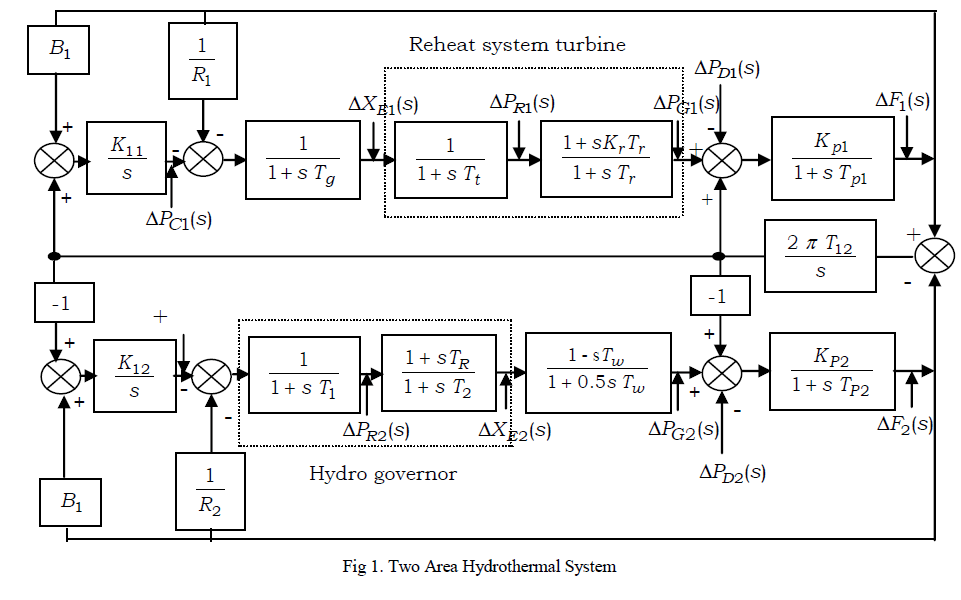 |
III. BLOCK DIAGRAM FORMULATION |
| In the restructured environment, Gencos sell power to various Discos at competitive prices. Thus, Discos have the liberty to choose the Gencos for contracts. They may or may not have contracts with the Gencos in their own area. This makes various combinations of Genco-Disco contracts possible in practice. The concept of a “Disco Participation Matrix” (DPM) is considered to make the visualization of contracts easier. DPM is a matrix with the number of rows equal to the number of Gencos and the number of columns equal to the number of Discos in the system. Each entry in this matrix can be thought of as a fraction of total load contracted by a Disco (Column) towards a Genco (row). Thus, the th ij entry corresponds to the fraction of the total load power contracted by Disco ‘j’ from a Genco ‘i’. The sum of all the entries in a Column in this matrix is unity. DPM shows the participation of a Disco in a contract with Genco; hence the name “Disco Participation Matrix”. DPM shows the participation of a Disco in a contract with any Genco, hence the name Disco Participation Matrix. |
| Whenever a load demanded by a Disco changes it is reflected as a local load in the area to which this Disco belongs. This corresponds to the local loads ïÂÂPL1 and ïÂÂPL2 which should be reflected in the deregulated AGC system block diagram at the point of input to the power system block. As there are many Gencos in each area, Area Control Error signal has to be distributed |
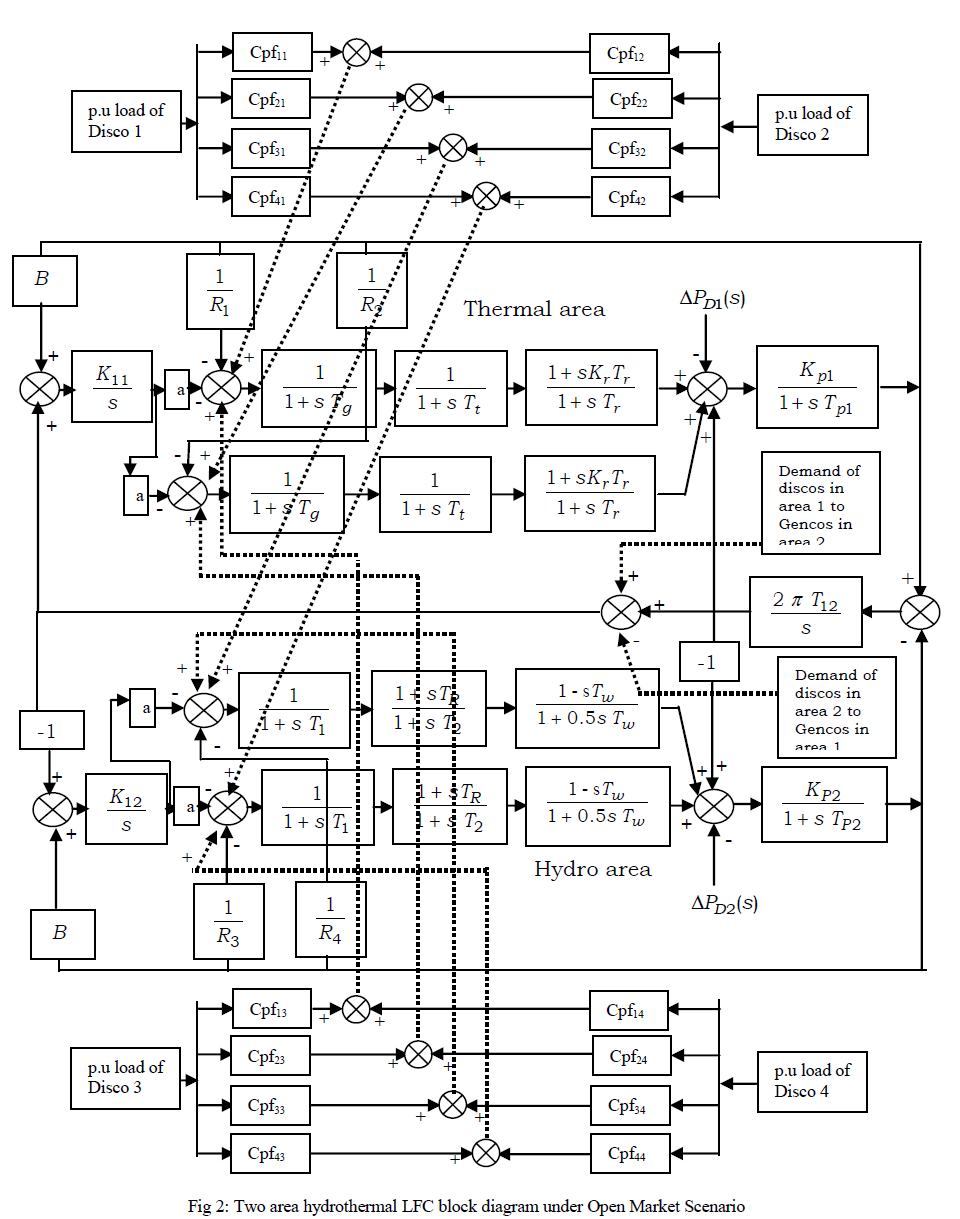 |
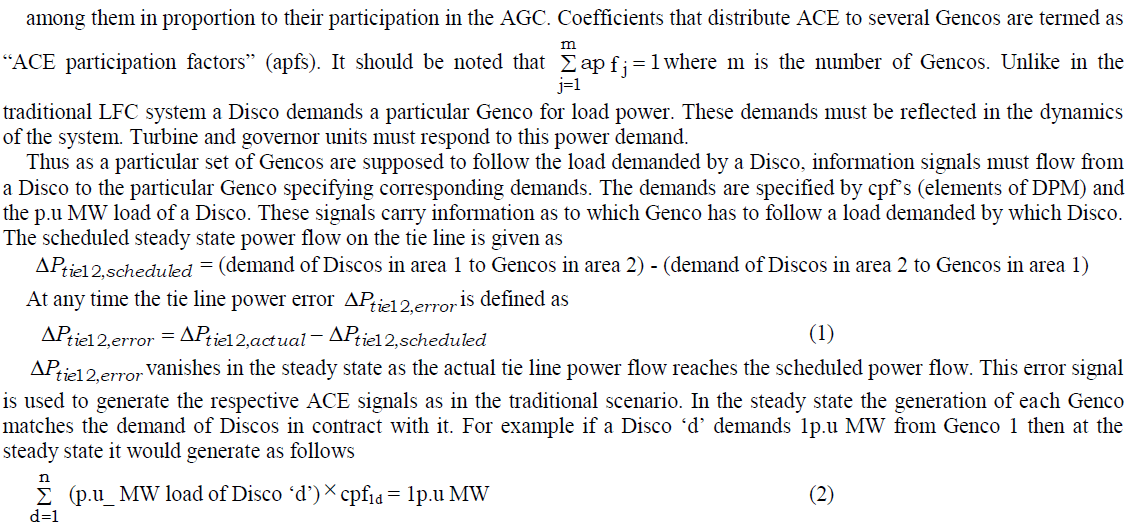 |
Contract Violation |
| It may happen that a Disco may violate a contract by demanding more than that specified in the contract. This excess power is not contracted out to any Genco. This uncontracted power must be supplied by the Gencos in the same area as that of the Disco. It must be reflected as a local load of the area but not as the contract demand. |
IV. RESULTS AND DISCUSSIONS |
| Simulation studies are performed to investigate the performance of the two-area hydrothermal system under open Environment. Consider a case where all the Gencos in each area participate equally in LFC. Here in the two-area hydrothermal system three Gencos and two Discos are considered in each area. It is assumed that there is 0.2% step load disturbance of each Disco, as a result of which the total step load disturbance in each area accounts to 0.4% and each Genco participates in AGC as defined by following area participation factors (apfs): |
 |
| A nominal value of 0.5 is considered for the gain setting of integral controller in both the areas. Table 1 gives the error between the theoretical and simulated values of generation for the above case. |
| Contract violation case has also been considered in this work. In this case it is considered that Disco1 demands additional load of 0.3% after 35 sec and Disco4 in area 2 demands additional load of 0.3% after 70 sec. It can be seen that the uncontracted power is supplied by the Gencos in the same area as that of the Disco which has demanded for additional power. Table 2 gives the generations of Gencos during contract violation. Figure3 shows the frequency deviations of area 1 and 2 with respect to the normal case. Figure 4 shows the tie line power error deviation. Figures 5 and 6 shows the generation of gencos of both areas. Figure 7 shows the frequency deviations during the contract violation and Figure 8 shows the tie line power error deviation during contract violation. Figures 9 and 10 depict the various generation of gencos during contract violation |
 |
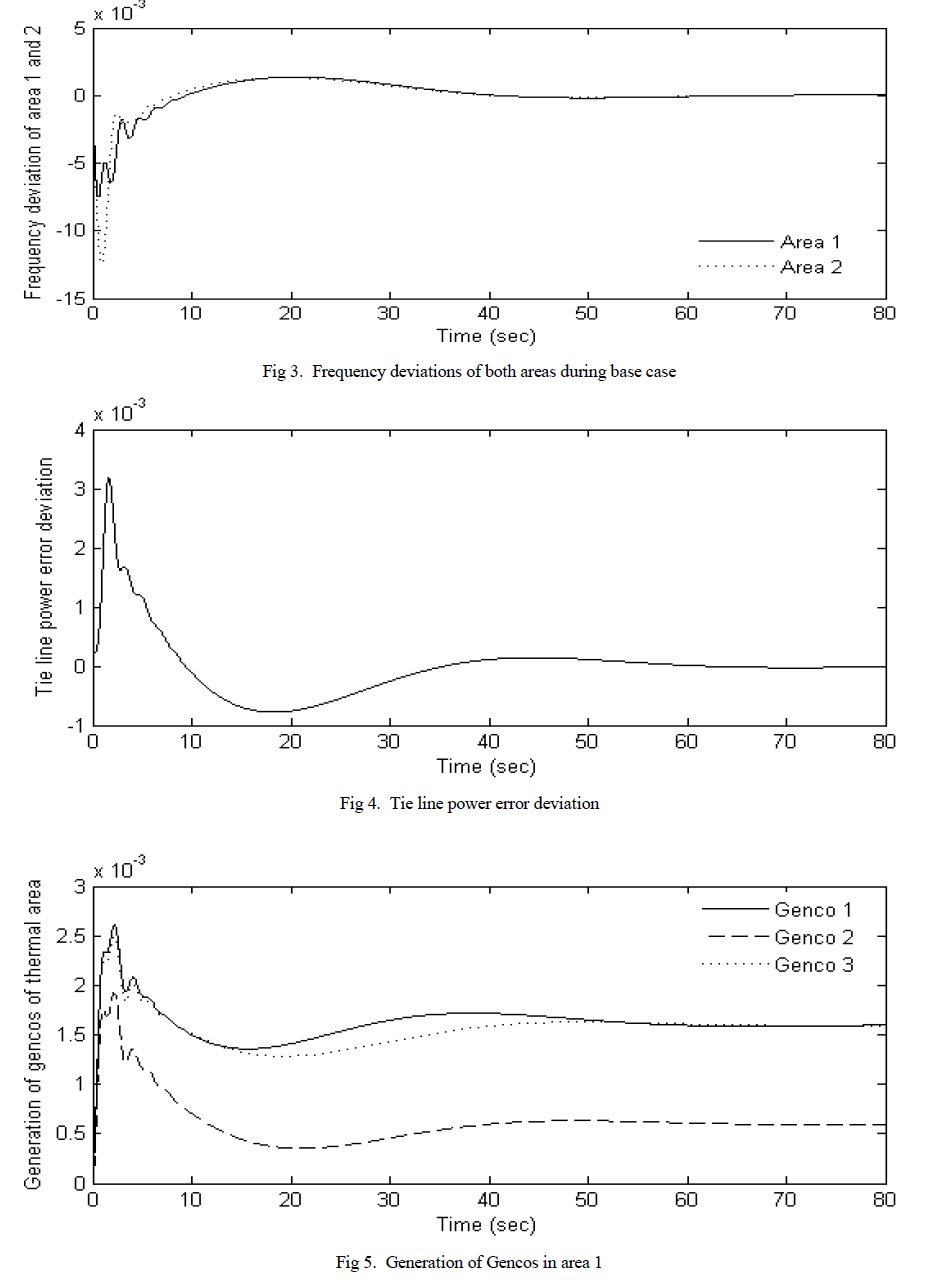 |
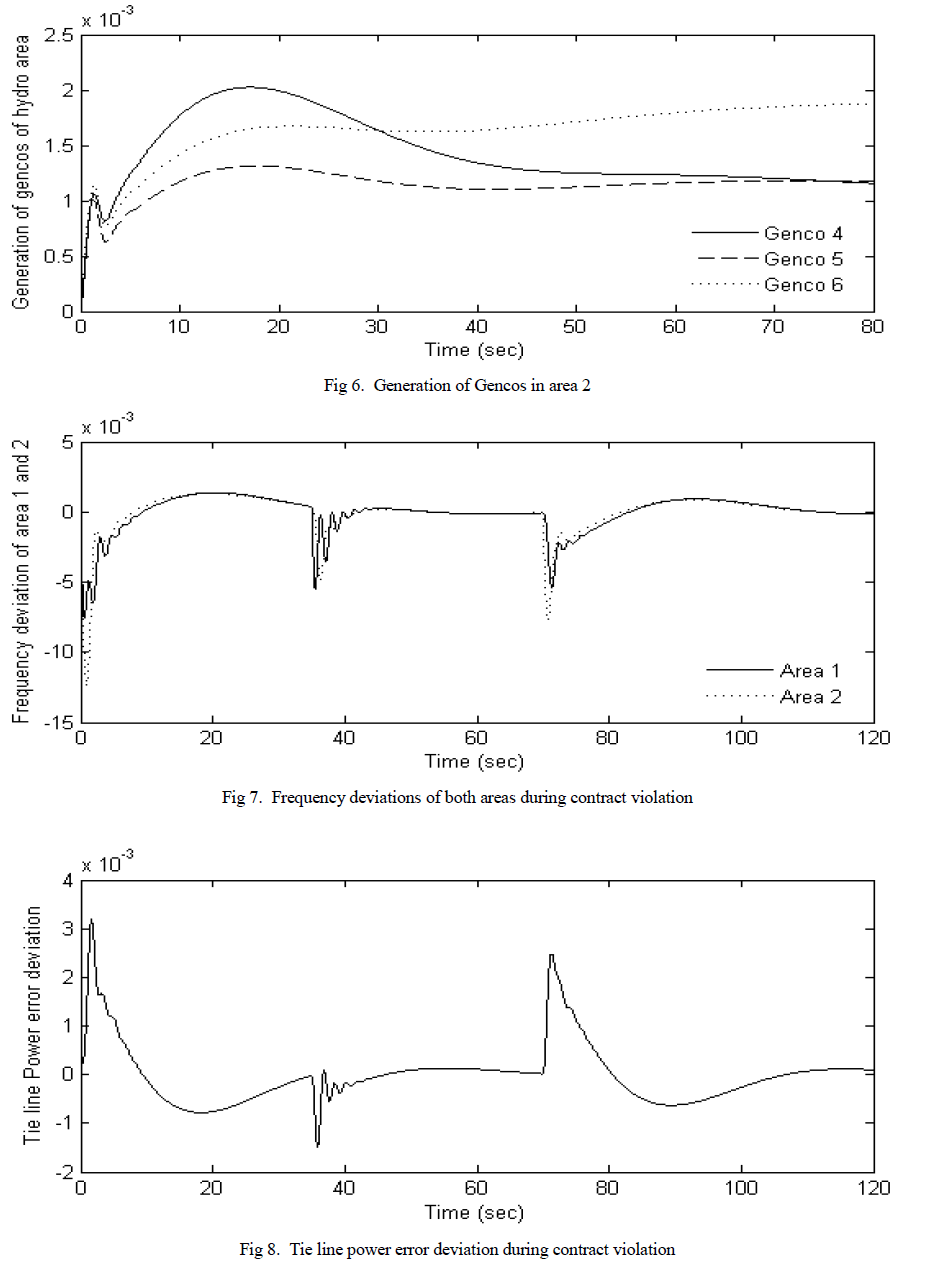 |
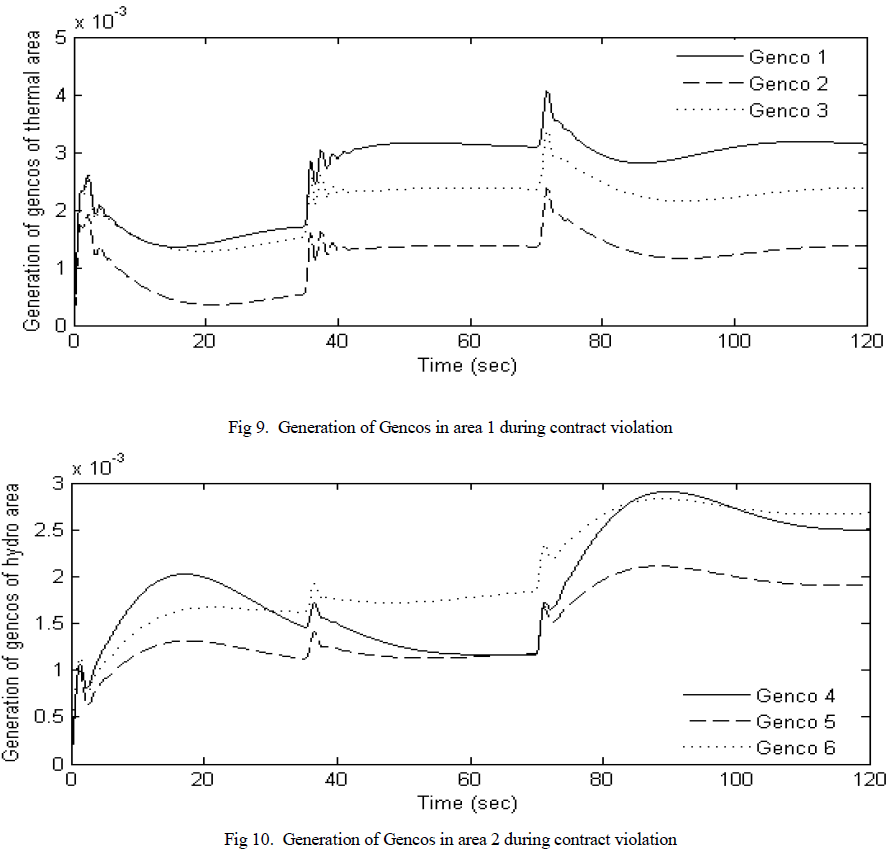 |
V. CONCLUSION |
| LFC provides a relatively, yet extremely effective method of adjusting generation to minimize frequency deviations and regulate tie-line flows. This important role of adjusting generation also continues in open market electricity markets. Bilateral contracts can exist between Discos in one area and Gencos in other areas. The concept of Disco Participation Matrix has been used in this work which provides a compact yet precise way of summarizing bilateral contracts in a multi area hydrothermal system under open market scenario. The modeling of LFC in an open market environment must take into account the information flow relating to bilateral contracts. |
APPENDIX |
| All the notations carry the usual meanings |
| (a) System data |
 |
References |
|